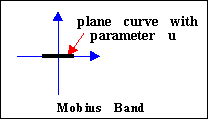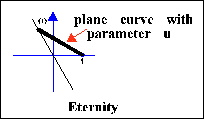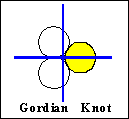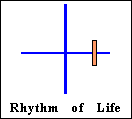How we made the Pictures
The more elaborate animations by Nick Mee were made using POVRAY.
However we can give more detail of the methodology of the other
animations.
Some of John's sculptures have a precise mathematical description:
this is so for example for ETERNITY, GORDIAN KNOT, DEPENDENT BEINGS,
MUSIC OF THE SPHERES, RHYTHM OF LIFE (see below for links). All
of these may be described as `fibre bundles', with base a circle,
and a 2-dimensional shape, called the fibre, which is slotted
onto the circle and twists as it moves around. The fibre bundle
needs for its description the base, fibre, and the amount of twist.
Amazingly, this mathematical description corresponds precisely
to how the first four of these were made! The interesting point
is that so many beautiful objects which stir the imagination are
described by simple exact formulae.
The original animations for this web site were constructed in
1996 using the drawing facilities of a symbolic computation package
called AXIOM, with its supplied facilities for making tubular
surfaces, and extra code by Larry Lambe for exporting to GEOMVIEW,
which gives a lot of control over various aspects of the figure.
For us, the advantages of AXIOM as a symbolic computation package
were: (i) all mathematical and datatype code is open, and so can
be modified and adapted for new purposes, (ii) the strongly typed
language, with parametric datatypes, inheritance, and coercion,
makes it appropriate for dealing with mathematical structures,
i.e. for dealing with mathematics, (iii) it was available, due
to an EPSRC grant to R. Brown and T. Porter for work in `Non abelian
homological algebra', (iv) the already written code in ntube.inputs
and in the export to GEOMVIEW files of Larry Lambe were exactly
suitable for the purpose in hand. Unfortunately, AXIOM is no longer
commercially available. However we give some description of the
methodology to illustrate the mathematical principles.
ntube.inputs
This file allows the specification of a base 3-dimensional curve,
called here the space curve; in all the five examples here, the
space curve is a circle, given by the formula [4*cos(t),4*sin(t),0],
for a range of values of t. Next one specifies a 2-dimensional
curve, giving the shape of the `fibre'. There are several ways
of specifying this for the given results, for example by specifying
the fibre as a square, triangle, and so on. We are able to specify
a twisting function, which rotates the plane curve by some function
depending on t as the plane curve moves along the space curve.
Because of this twisting, it was possible to specify the plane
curve in a simpler fashion, as only a part of the fibre, but allowing
a multiple traverse of the space curve.
A final point of information is the number of steps for each of
the u and t variables. The payoff here is that a small number
of steps leads to a quickly executing program, but the result
can be jagged. The effect is often interesting, but not what was
intended as a model of the sculpture. A small amount of jaggedness
will be smoothed satisfactorily in the GEOMVIEW program.
The details are as follows:
Möbius Band
| The space curve is a circle, radius 4, traversed for t from 0
to 2p. The plane curve is the line segment on the x-axis from -1 to
1. The twisting is by t/2. (That page contains an animation.) |
|
Dependent Beings
| This is made of two Möbius bands put together, rather than a twisting
square, since this is simpler to code and also allows the two
bands to be of different colour, as in the sculpture.(We made
an animation of this, and also there is Nick Mee's animation.) |
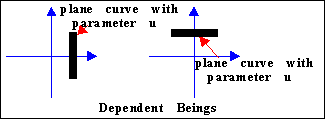 |
Eternity
| The plane curve is given in complex number notation by (1-u) +uw, where 0 £ u £ 1, and w is the complex cube root of 1. (Here £ means `less than or equal to'.) The range of t is from 0 to
6p, and the twist is by t/3. See Nick Mee's animation. |
|
Music of the Spheres
| The base circle is of radius 4, traversed 3 times. The plane curve
is given by [1+ cosu, sinu] if 0 £ u £ 2p/3, and by [cos(-u +p/3), sin(-u+p/3) +…[ 3] ] for 2p/3 £ u £ 4p/3. The twisting is by t/3. See Nick Mee's animation. |
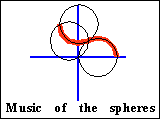
|
Gordian Knot
| The base circle is of radius 5, traversed 3 times. The plane curve
is the circle [cosu + 2/…3 , sinu] centre ((2/…3), 0) and radius
1, and the twist is by 8t/3. (See also Nick Mee's animation.) |
|
Rhythm of Life
| The base circle is of radius 2, traversed 4 times. The plane curve is a rectangle centre (1,0) and of sides 0.4 and 0.1. The twisting is by 15t. See Nick Mee's animation. |
|
Bonds of Friendship
This is obtained by creating two toruses in 3-space, using the
draw function, with a tube around the curve. The radius of each
tube is 0.5, and one of them is given by the curve (sin(t),cos(t),0) and the other by the curve (0,1+sin(t), cos(t)). See Nick Mee's animation
Immortality
Here it was necessary to take the space curve to be a trefoil
knot, and the plane curve to be a rectangle. We found it difficult
to model the sculpture exactly, since the trefoil curve as used
by John was not described by the simple mathematical formulae
we tried. Also, the twisting of the curve was unduly reflected
in the twisting of the rectangle, and so again the formulae we
used does not give an exact model. To do so, a lot more experimentation
would be needed. So the animations here are by Nick Mee. See Nick
Mee's animation
Möbius Band | Dependent Beings

© Mathematics and Knots/Edition Limitee 1996 - 2002
This material may be used freely for educational, artistic and
scientific purposes, with acknowledgement, but may not be used for commercial purposes, for profit or in texts
without the permission of the publishers.
